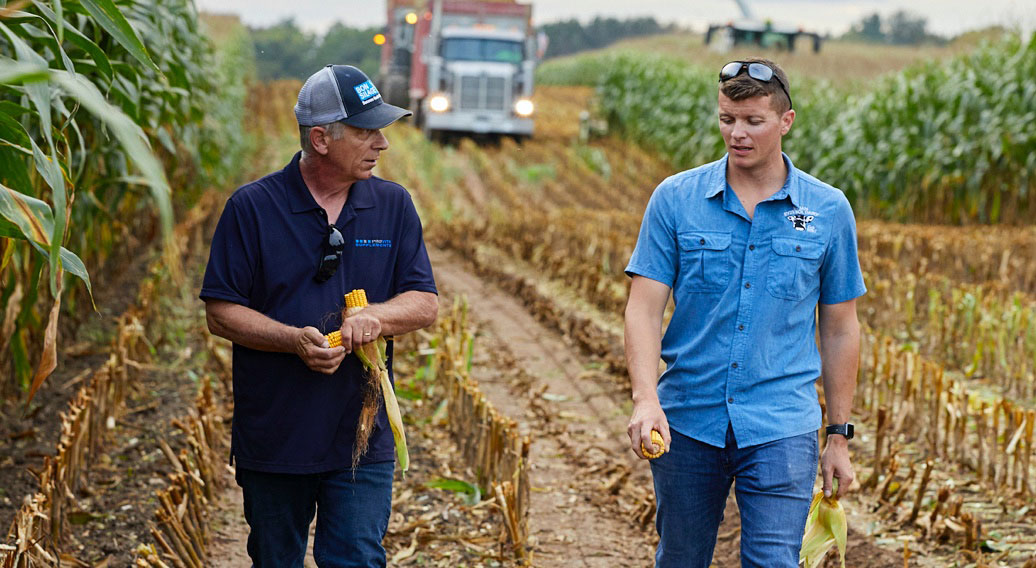Service

bonsilage® #how2
See the video below to learn how to properly mix your bonsilage® product.
Product guide
The product guide provides an initial overview of the enitre bonsilage® range and shows which inoculant is suitable for your individual requirements
| CORN+ | PRO | SPEED C | SPEED G | FORTE | ALFA | BASIC | |
|---|---|---|---|---|---|---|---|
| Corn Silage | 55-72% | 62-72% | 55-72 % | — | — | — | 65-75% |
| Sorghum Silage | 55-72% | 62-72% | 55-72% | — | — | — | 65-75% |
| Sorghum Sudan Grass Silage | 55-72% | 62-72% | 55-72% | — | — | — | 65-75% |
| High-Moisture Corn | 30-42% | — | 30-42% | — | — | — | — |
| Earlage/Snaplage | 35-42% | — | 35-42% | — | — | — | — |
| Small Grain Silage | — | — | 50-65% | — | 65-78% | 55-70% | 65-75% |
| Grass Haylage | — | — | — | 55-72% | 65-78% | 55-70% | 65-75% |
| Clover Grass Haylage | — | — | — | 55-72% | 65-75% | 55-70% | 65-75% |
| Alfalfa Haylage | — | — | — | — | 65-75% | 55-70% | 65-75% |
| CORN+ | PRO | SPEED C | SPEED G | FORTE | ALFA | BASIC | |
|---|---|---|---|---|---|---|---|
| Quick pH Drop | ++ | ++ | ++ | ++ | ++ | ++ | ++ |
| Improved Aerobic Stability | ++ | + | ++ | ++ | + | ||
| Glucogenic Effect | ++ | + | + | ||||
| DM & Nutrient Retention | ++ | ++ | ++ | ++ | ++ | ++ | ++ |
| Fiber Digestibility | + | + | + | + | + | + | + |
| Clostridia Inhibition | ++ | ++ | |||||
| Reduction of Biogenic Amines | ++ | ++ | |||||
| Shortened Fermentation Time | ++ | ++ | + | + |
| CORN+ | PRO | SPEED C | SPEED G | FORTE | ALFA | BASIC | |
|---|---|---|---|---|---|---|---|
| Application CFU/g Forage | 500,000 | 150,000 | 300,000 | 300,00 | 300,000 | 300,000 | 100,000 |
| Lb. buchneri (heteroferm.) | ✓ | ✓ | ✓ | ✓ | |||
| Lb. brevis (heteroferm.) | ✓ | ✓ | |||||
| Lb. diolivorans | ✓ | ✓ | |||||
| Lb. plantarum (homoferm.) | ✓ | ✓ | ✓ | ✓ | ✓ | ✓ | |
| Lc. lactis (homoferm.) | ✓ | ✓ | |||||
| Pc. acidilactici (homoferm.) | ✓ | ✓ | |||||
| Pc. pentosaceus (homoferm.) | ✓ |
Did you know...
Here you can find the most frequently asked questions about our bonsilage® products, silages and the general ensiling process. We summarized some silage management tips in our handy checklist that can be downloaded below.
Please do not hesitate to contact us if you do not find the answer to your questions.

- Unopened cans can be stored for up to 24 months from production date. bonsilage® OMRI listed products can be stored for up to 12 month from production date.
- Cans do not need to be refrigerated and can be stored at room temperature (70° F), out of sunlight.
- 24 – 48 hours if kept cool (60 – 70° F).
- If kept refrigerated (40° F) it can be stored for 1 week.
No, by storing the solution in the freezer the bacteria might get killed.
Yes, by laboratory analysis: Product-specific fermentation patterns can be identified and thus the efficacy can be proven!
No, by using the right bonsilage® product, which is designed for forages containing low dry matter levels it is not necessary to increase the dosage!
Silages containing very low dry matter contents are prone for butyric acid fermentation, while silages contain high dry matter levels are prone for reheating during feed-out.
- Each forage has its own requirements and therefore bonsilage® products are specially tailored to those requirements.
- Also, special fermentation add-ons such as the formation of propylene glycol require high concentrations of special LAB.
Yes, several bonsilage® products have a targeted effect against molds!
- The decisive factor is which microorganisms have produced the acetic acid during the ensiling process. Undesirable fermentation failures result in the formation of not only acetic acid, but also other unwanted substances that reduce feed intake and cause high dry matter losses during the ensiling process.
- Acetic acid produced by Lb. buchneri does not lower the intake!
bonsilage® is a purely biological silage additive that induce a lactic acid fermentation with all its benefits (e.g. pleasant smell, high palatability etc.) Chemical products have a preservative effect only without mentioned additional positive effects.
Short wilting time times promote ensilability and prevent carbohydrate losses. They additionally improve protein quality, as proteolysis is reduced.
Testimonials

What we need is optimal, just great quality silage. And this is what really works for us with bonsilage!

Since we have been using bonsilage inoculants, we do have a higher quality and higher standard of silage.

One benefit of using bonsilage inoculants is that when to open up a new bag or a new pit, there’s very little concern that what’s coming out will not have ensiled properly.
bonsilage® - Your challenge. Our commitment.
Schedule an expert consultation
